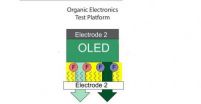(Press-News.org) Scientists are facing a number of barriers as they try to develop circuits that are microscopic in size, including how to reliably control the current that flows through a circuit that is the width of a single molecule.
Alexander Shestopalov, an assistant professor of chemical engineering at the University of Rochester, has done just that, thereby taking us one step closer to nanoscale circuitry.
"Until now, scientists have been unable to reliably direct a charge from one molecule to another," said Shestopalov. "But that's exactly what we need to do when working with electronic circuits that are one or two molecules thin."
Shestopalov worked with an OLED (organic light-emitting diode) powered by a microscopically small, simple circuit in which he connected a one-molecule thin sheet of organic material between positive and negative electrodes. Recent research publications have shown that it is difficult to control the current traveling through the circuit from one electrode to the other in such a thin circuit. As Shestopalov explains in a paper published in the journal Advanced Material Interfaces, the key was adding a second, inert layer of molecules.
The inert—or non-reactive—layer is made of a straight chain of organic molecules. On top a layer of aromatic—or ring-shaped—molecules acts like a wire conducting the electronic charge. The inert layer, in effect, acts like the plastic casing on electric wires by insulating and separating the live wires from the surrounding environment. Since the bottom layer is not capable of reacting with the overlapping layer, the electronic properties of the component are determined solely within the top layer.
The bi-layer arrangement also gave Shestopalov the ability to fine-tune his control of the charge transfer. By changing the functional groups—units of atoms that replace hydrogen in molecules and determine a molecule's characteristic chemical reactivity—he could more precisely affect the rate at which the current moved between the electrodes and the upper layer of organic molecules.
In molecular electronic devices, some functional groups accelerate the charge transfer, while others slow it down. By incorporating the inert layer of molecules, Shestopalov was able to reduce any interference with the top layer and, as a result, achieve the precise charge transfer needed in a device by changing the functional group.
For example, an OLED may need a faster charge transfer to maintain a specific luminescence, while a biomedical injection device may require a slower rate for delicate or variable procedures.
While Shestopalov overcame a significant obstacle, there remains a great deal of work to be done before bi-layer molecular electronic devices become practical. The next obstacle is durability.
"The system we developed degrades quickly at high temperatures," said Shestopalov. "What we need are devices that last for years, and that will take time to accomplish.
INFORMATION:
Shestopalov's research was funded by the National Science Foundation and University of Rochester ChemE Startup.
Progress made in developing nanoscale electronics
New research directs charges through single molecules
2014-04-21
ELSE PRESS RELEASES FROM THIS DATE:
A gene within a gene contributes to the aggressiveness of acute myeloid leukemia
2014-04-21
COLUMBUS, Ohio – A small gene that is embedded in a larger, well-known gene is the true leukemia-promoting force usually attributed to the larger gene, according to a new study by researchers at The Ohio State University Comprehensive Cancer Center – Arthur G. James Cancer Hospital and Richard J. Solove Research Institute (OSUCCC – James).
The findings are published in the journal Science Signaling.
The larger host gene is called BAALC (pronounced "Ball C"). The smaller embedded gene is called microRNA-3151 (miR-3151). The study investigated the degree to which each ...
Simulating in tiny steps gave birth to long-sought-after method
2014-04-21
Using computer simulations to predict which drug candidates offer the greatest potential has thus far not been very reliable, because both small drug-like molecules and the amino acids of proteins vary so much in their chemistry. Uppsala researchers have now cunningly managed to develop a method that has proven to be precise, reliable and general.
The largest class of human target proteins for drugs are the so-called G-protein-coupled receptors. They are targets for about 40 per cent of all drugs on the market. These receptors are found in the cell membrane and handle ...
Lack of breeding threatens blue-footed boobies' survival
2014-04-21
Blue-footed Boobies are on the decline in the Galápagos.
A new study appearing in the journal Avian Conservation and Ecology indicates numbers of the iconic birds, known for their bright blue feet and propensity to burst into dance to attract mates, have fallen more than 50 percent in less than 20 years.
The drastic drop in population is probably due to an unexplained disappearance of sardines from the Boobies' diet, said Dave Anderson, a professor of biology at Wake Forest University and the study's principal investigator. This in turn has adult Boobies electing not ...
NASA sees wind shear affecting newborn Tropical Cyclone Jack
2014-04-21
Tropical Cyclone Jack may have hurricane-force winds today, April 21, but strong vertical wind shear is expected to weaken the storm. NASA's TRMM satellite passed overhead and saw that the bulk of the storm's rainfall was being pushed south of the center from the wind shear.
Tropical Cyclone Jack formed on Sunday, April 20, near 13.4 south and 91.1 east, and began moving to the south at 6 knots/6.9 mph/11.1 kph. Jack strengthened quickly and hours after its birth, the storm already had maximum sustained winds near 55 knots/63.2 mph/101.9 kph.
On April 21 at 0900 UTC/5 ...
Taking the pulse of mountain formation in the Andes
2014-04-21
Scientists have long been trying to understand how the Andes and other broad, high-elevation mountain ranges were formed. New research by Carmala Garzione, a professor of earth and environmental sciences at the University of Rochester, and colleagues sheds light on the mystery.
In a paper published in the latest Earth and Planetary Science Letters, Garzione explains that the Altiplano plateau in the central Andes—and most likely the entire mountain range—was formed through a series of rapid growth spurts.
"This study provides increasing evidence that the plateau formed ...
Edible flowers may inhibit chronic diseases
2014-04-21
A new study in the Journal of Food Science, published by the Institute of Food Technologists (IFT), found that common edible flowers in China are rich in phenolics and have excellent antioxidant capacity. Edible flowers, which have been used in the culinary arts in China for centuries, are receiving renewed interest. Flowers can be used as an essential ingredient in a recipe, provide seasoning to a dish, or simply be used as a garnish. Some of these flowers contain phenolics that have been correlated with anti-inflammatory activity and a reduced risk of cardiovascular disease ...
MSU physicists push new Parkinson's treatment toward clinical trials
2014-04-21
EAST LANSING, Mich. --- The most effective way to tackle debilitating diseases is to punch them at the start and keep them from growing.
Research at Michigan State University, published in the Journal of Biological Chemistry, shows that a small "molecular tweezer" keeps proteins from clumping, or aggregating, the first step of neurological disorders such as Parkinson's disease, Alzheimer's disease and Huntington's disease.
The results are pushing the promising molecule toward clinical trials and actually becoming a new drug, said Lisa Lapidus, MSU associate professor ...
The anti-inflammatory factory
2014-04-21
Russian scientists, in collaboration with their colleagues from Pittsburgh University, find how lipid mediators are produced. The relevant paper was publish in Nature Chemistry. Lipid mediators are molecules playing an important role in inflammation process. A study devoted to some of them has earned a Nobel prize in 1982.
Mitochondria are known as "cellular power plants", the organelles where oxidation of various substances leads to formation of adenosine triphosphate (ATP), a molecule universally used for storage and transportation of energy inside cells. But this is ...
IU study: Death of public figures provides important opportunities for health education
2014-04-21
BLOOMINGTON, Ind. -- An Indiana University study of reactions to the 2011 death of Apple co-founder Steve Jobs suggests health communicators have a critical window of opportunity after a public figure dies to disseminate information about disease prevention and detection.
The study, involving a survey of 1,400 adult men and women, found that immediately after Jobs' death, more than a third of survey participants sought information about how he died or about cancer in general, and 7 percent sought information about pancreatic cancer, the disease that took Jobs' life.
Lead ...
Allina Health study shows information sharing between health systems reduces tests
2014-04-21
MINNEAPOLIS – (April 21, 2014) – An Allina Health study published in the current issue of the journal Applied Clinical Informatics showed that a significant number of diagnostic tests and procedures can be avoided if clinicians exchange health information with other health systems.
Allina Health uses Care Everywhere which is a health information exchange tool embedded in the Allina Health electronic health record called Excellian® that is powered by Epic (Epic Systems Corporation, Verona, Wis.) With patient consent, Allina Health providers can use this tool to exchange ...
LAST 30 PRESS RELEASES:
On-demand upgraded recycling of polyethylene and construction of sustainable multifunctional materials based on the "LEGO" strategy
New "Stomata in-sight" system allows scientists to watch plants breathe in real-time
Anorexia nervosa may result in long-term skeletal muscle impairment
Narrative-based performance reviews deemed fairest by employees
New insights reveal how advanced oxidation can tackle emerging water pollutants
New review shows how biomass can deliver low-carbon gaseous fuels at scale
Climate change is quietly rewriting the world’s nitrogen cycle, with high stakes for food and the environment
Study finds SGLT-2 inhibitors linked to lower risk of diabetic foot nerve damage
Microbes may hold the key to brain evolution
Study examines how the last two respiratory pandemics rapidly spread through cities
Gender stereotypes reflect the division of labor between women and men across nations
Orthopedics can play critical role in identifying intimate partner violence
Worms as particle sweepers
Second spider-parasitic mite described in Brazil
January 2026 issues of APA journals feature new research on autism, pediatric anxiety, psychedelic therapy, suicide prevention and more
Private equity acquired more than 500 autism centers over the past decade, new study shows
New cervical cancer screening guidelines from the US Department of Health and Human Services
Estimated burden of COVID-19 illnesses, medical visits, hospitalizations, and deaths in the US from October 2022 to September 2024
Smartphone use during school hours by US youth
Food insecurity and adverse social conditions tied to increased risk of long COVID in children
Earliest, hottest galaxy cluster gas on record could change our cosmological models
Greenland’s Prudhoe Dome ice cap was completely gone only 7,000 years ago, first GreenDrill study finds
Scientific validity of blue zones longevity research confirmed
Injectable breast ‘implant’ offers alternative to traditional surgeries
Neuroscientists devise formulas to measure multilingualism
New prostate cancer trial seeks to reduce toxicity without sacrificing efficacy
Geometry shapes life
A CRISPR screen reveals many previously unrecognized genes required for brain development and a new neurodevelopmental disorder
Hot flush treatment has anti-breast cancer activity, study finds
Securing AI systems against growing cybersecurity threats
[Press-News.org] Progress made in developing nanoscale electronicsNew research directs charges through single molecules




